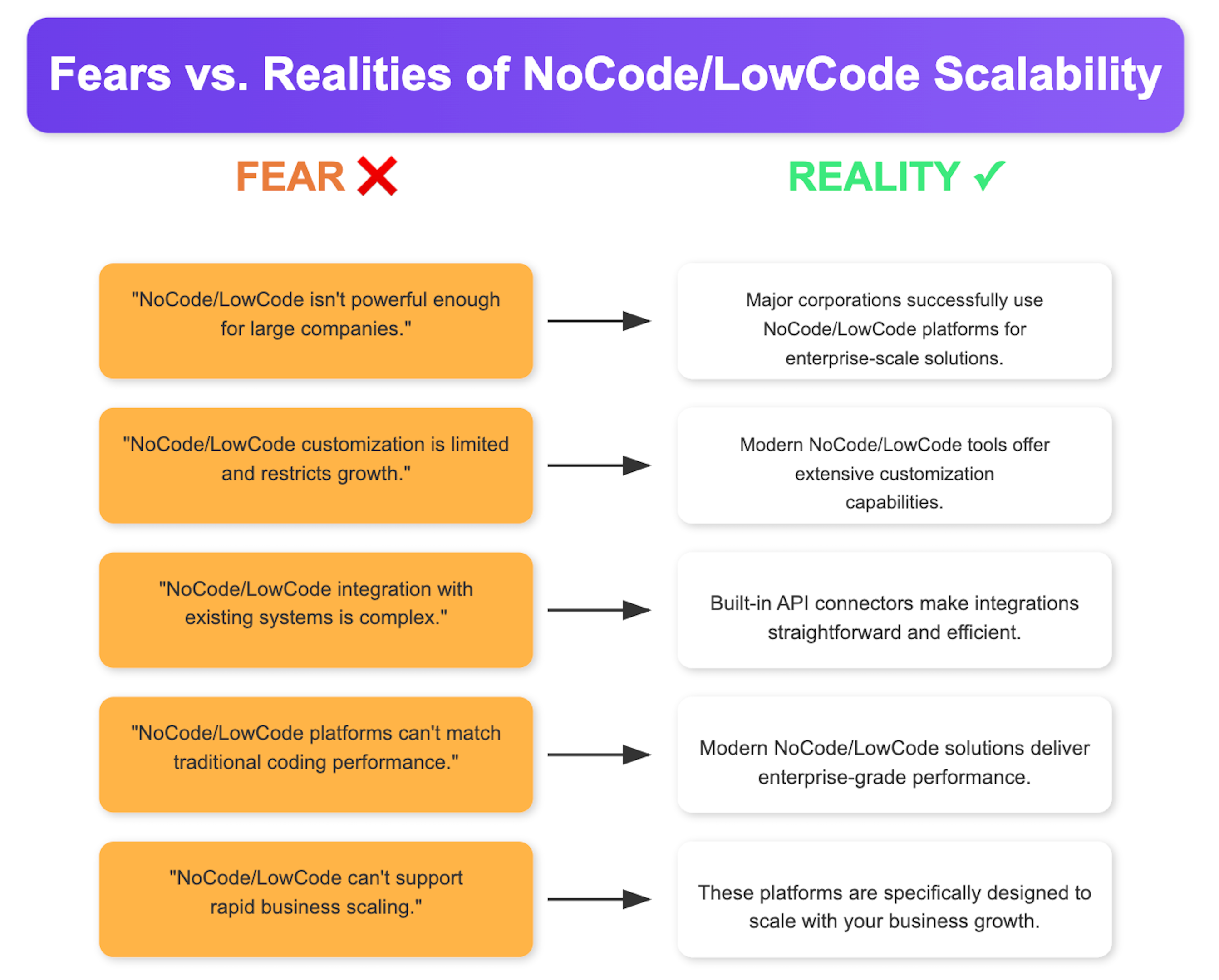

Fears vs. Realities of NoCode/LowCode Scalability
Publié le 02 février 2025
Écrit par Jaren Hidalgo - Lecture de 11 minutes
Wondering if NoCode/LowCode platforms can scale as your business grows? Despite common misconceptions, both these tools can indeed handle complexity and large-scale projects. This article will debunk myths, provide real-world examples, and detail the key factors that influence NoCode/LowCode scalability. Find out how these platforms promise greater user accessibility, innovation, and efficiency, enabling businesses to adapt quickly to market changes and streamline their development processes without extensive coding knowledge.
Principaux enseignements
NoCode/LowCode platforms enable rapid growth and adaptation for businesses, debunking myths about their scalability and complexity handling.
Real-world examples like Coca-Cola and IKEA demonstrate the effectiveness of NoCode/LowCode tools in managing large-scale applications and improving efficiency.
The future of NoCode/LowCode is bright, with projections indicating significant market growth and an increasing number of non-technical users driving innovation.
Understanding NoCode/LowCode Scalability

NoCode and LowCode platforms are designed to facilitate rapid growth and adaptation. They allow businesses to make quick adjustments based on customer feedback, keeping them agile and competitive in today’s fast-paced digital landscape. The very essence of these platforms is to democratize application development, enabling teams to create innovative products without the need for extensive coding knowledge.
One common misconception is that NoCode/LowCode tools cannot scale effectively compared to traditional coding methods. However, this is far from the truth. These platforms can significantly reduce development timelines, allowing businesses to respond to market demands swiftly. For instance, Webflow exemplifies the scalability of NoCode tools by combining design flexibility with performance optimization. Additionally, platforms like Xano provide advanced control over app data and the underlying infrastructure necessary for robust application performance and scalability.
Moreover, the NoCode/LowCode market is booming, with projections indicating substantial growth. The market for NoCode tools is projected to reach $65 billion by 2025, demonstrating their growing importance and scalability. Businesses that adopt these platforms can streamline product development processes and reduce barriers to entry, fostering a culture of adaptability and innovation. These tools enhance productivity by streamlining processes and automating repetitive tasks, ultimately addressing common workflow bottlenecks in various sectors.
Definition of NoCode and LowCode
NoCode and LowCode are revolutionary approaches in software development that empower users to create applications without needing extensive coding knowledge. NoCode platforms are designed to be incredibly user-friendly, allowing users to build applications without writing a single line of code. These platforms typically feature visual interfaces and drag-and-drop tools, making it easy for anyone to create functional applications quickly.
On the other hand, LowCode platforms require some coding knowledge but offer a more streamlined and efficient development process. These platforms provide pre-built components and templates that developers can customize with minimal coding. This approach significantly reduces development time while still allowing for a higher degree of customization and complexity.
Key Differences Between NoCode and LowCode
The primary differences between NoCode and LowCode platforms lie in the level of coding required and the complexity of the applications that can be built. NoCode platforms are tailored for non-technical users, such as citizen developers, who want to create simple applications without writing any code. These platforms are perfect for building straightforward applications quickly and efficiently.
In contrast, LowCode platforms are designed for developers who need to build more complex applications with a higher degree of customization. While LowCode platforms still simplify the development process, they require some coding knowledge, allowing developers to create more sophisticated and tailored solutions. This makes LowCode an excellent choice for projects that need a balance between ease of use and customization.
Brief History and Evolution of NoCode/LowCode
The concept of NoCode and LowCode has been evolving for several years, but it has gained significant traction recently due to the increasing demand for rapid digital transformation. Initially, these platforms were seen as tools for simple application development, but their capabilities have expanded dramatically. Today, NoCode and LowCode platforms are robust enough to handle a wide range of applications, from basic web forms to complex enterprise solutions.
The rise of these platforms can be attributed to the need for faster and more efficient software development processes. Businesses are under constant pressure to innovate and adapt quickly, and NoCode/LowCode platforms provide the perfect solution. With numerous platforms available today, each offering unique features and capabilities, businesses have a wealth of options to choose from to meet their specific needs.
Myths About NoCode/LowCode Platforms

Despite their growing popularity, many myths surround NoCode and LowCode platforms. A prevalent myth is that these platforms are incapable of supporting complex workflows. In reality, they offer features like automation and conditional logic, enabling the development of sophisticated applications without the traditional programming challenges.
NoCode/LowCode platforms are designed to provide a smooth user experience, ensuring that even not so technical users can navigate the tools effectively.
Many believe that NoCode/LowCode platforms struggle under pressure and can’t scale effectively. This myth is debunked as many platforms offer custom plugins and scripting environments for backend customizations, enhancing performance and scalability. These platforms are built to handle a variety of use cases, from simple tasks to complex enterprise-grade applications.
Additionally, it’s misguided to think that NoCode/LowCode platforms are only for non-technical users. These platforms empower non-technical users to create applications and offer robust tools for professional developers to build and scale efficiently. This blend of accessibility and power makes them a versatile choice for different types of projects and users.
Real-World Examples of NoCode/LowCode Scalability

Examining real-world examples can provide a clearer picture of NoCode and LowCode scalability. Coca-Cola Bottling Company United utilized Power Automate to streamline their vending machine management, significantly enhancing operational processes. This example shows how even large-scale operations can benefit from these platforms.
De même, Johnson Controls a mis au point un nouveau système de déploiement de la formation à l'aide de Microsoft Power Platform, ce qui a permis d'améliorer les performances et la prestation de services. Ce succès souligne la capacité de la plateforme à gérer des applications complexes et à obtenir des résultats commerciaux significatifs.
NoCode/LowCode platforms also enable users to generate detailed reports that aid in understanding process efficiencies and performance metrics.
Another notable example is Rabobank, which integrated Power Platform to run over 2,500 applications, automating a significant portion of customer inquiries for business users. Major corporations like Google and Microsoft also leverage NoCode/LowCode platforms to build significant systems.
IKEA, for instance, created over 430 apps using Microsoft’s Power Platform, greatly improving their operational efficiency. These cases show that NoCode/LowCode platforms can handle large, complex applications effectively, not just small projects.
Key Factors Influencing NoCode/LowCode Scalability
Several key factors influence the scalability of NoCode/LowCode platforms. A crucial factor is the platform’s backend architecture. A well-structured backend can significantly enhance scalability by reducing data transmission delays and ensuring efficient data management. Selecting a platform that supports both horizontal and vertical scaling is essential for maintaining performance as the application expands.
NoCode/LowCode platforms facilitate collaboration and streamline work processes among teams, making it easier for both tech-savvy and non-technical users to contribute effectively.
La complexité de l'application influe considérablement sur son évolutivité. Les applications plus complexes nécessitent des solutions robustes pour gérer efficacement la croissance. Un contrôle régulier des performances et la fixation d'objectifs spécifiques, tels que le temps de réponse et le débit, garantissent une évolution harmonieuse de l'application.
Another factor influencing scalability is integration with other systems. NoCode platforms must be carefully optimized to avoid latency issues when connecting with external systems. Employing data management strategies like PostgreSQL or cloud-native databases can also enhance scalability. These elements collectively enable the platform to scale and meet expanding business requirements.
Garantir l'intégrité et la sécurité des données
Ensuring data integrity and security is paramount for NoCode/LowCode platforms. These platforms incorporate built-in security features such as encryption and user authentication to protect sensitive data from unauthorized access. Data encryption converts information into a secure format during transmission and storage, making it unreadable without the correct keys.
Les contrôles d'accès basés sur les rôles renforcent la sécurité en permettant aux administrateurs de restreindre l'accès aux données en fonction des rôles des utilisateurs. Cela garantit que seul le personnel autorisé peut accéder aux informations sensibles. Le code généré est normalisé et testé de manière approfondie, ce qui réduit considérablement les risques de vulnérabilité.
Moreover, NoCode/LowCode platforms offer security measures that are as robust as traditional software, including multi-factor authentication. These features collectively maintain data integrity and security, giving businesses confidence in using these platforms for critical applications.
Performance Optimization in NoCode/LowCode Development
Performance optimization is vital for maintaining optimal performance and scalability in NoCode/LowCode development. Scalability is a platform’s ability to handle growth in users, data volume, and functionality without degrading performance. Efficient resource management, such as automated resource allocation and smart caching, is key to maintaining smooth application performance.
Les tests de performance précoces permettent d'identifier les goulets d'étranglement avant qu'ils ne causent des problèmes. L'automatisation des tests améliore l'efficacité et la précision, et permet de simuler diverses interactions avec les utilisateurs afin d'analyser leur comportement. Les tests de charge, qui simulent le trafic des utilisateurs, sont essentiels pour évaluer les performances des applications en fonction des demandes.
Caching strategies can significantly improve response times and reduce server load in NoCode/LowCode applications. These platforms can reduce development time by up to 45%, allowing businesses to quickly respond to market changes. Focusing on performance optimization ensures NoCode/LowCode applications scale effectively.
Donner aux utilisateurs non techniques les moyens d'agir grâce à des solutions évolutives

NoCode and LowCode platforms are not just for professional developers; they empower non-technical users to create scalable solutions. By 2026, over 80% of NoCode platform users are expected to be not so technical individuals. These platforms allow organizations to swiftly develop applications, enabling non-technical employees to create solutions for specific business needs.
NoCode platforms encourage collaboration by connecting tech-savvy and non-technical users. This collaboration enhances project timelines and outcomes, with diverse teams working together. Platforms like Microsoft PowerApps, for example, allow users to integrate AI capabilities into their no code apps without requiring programming knowledge.
Conducting interactive support sessions, such as webinars, online meetings and/or is crucial for effectively teaching users and ensuring high engagement and uptake of NoCode/LowCode technologies. Mere setup without active training often leads to poor execution and results.
Beginning with smaller projects helps understand the platform’s capabilities and minimize errors. NoCode/LowCode platforms drastically reduce time-to-market for applications, allowing organizations to quickly respond to customer needs. Empowering non-technical users, these platforms drive innovation and yield better results.
Supporting Complex Applications with NoCode/LowCode
NoCode and LowCode platforms are capable of supporting complex applications. Platforms with full-stack capabilities and compilation can maintain performance while managing sophisticated applications. They can effectively integrate with existing enterprise software using API management tools and pre-built connectors.
NoCode tools seamlessly integrate with various data sources, APIs, and web services, ensuring a cohesive application experience. Although there are some flexibility limitations, these platforms often support open APIs and data portability. LowCode platforms handle more complex, enterprise-grade use cases and larger data volumes better than most no code tools.
Ces plateformes peuvent gérer de nombreux utilisateurs, de grands volumes d'informations et des tâches complexes. Soutenant des projets complexes, elles gèrent efficacement des applications web sophistiquées et se révèlent adaptées à des tâches complexes et à grande échelle.
Best Practices for Scaling NoCode/LowCode Applications

Effective scaling of NoCode/LowCode applications necessitates following best practices in the software development process. Proper development planning, including requirement definition and testing, is crucial for successful project management. Automated CI/CD processes in some platforms facilitate reliable updates and scalability.
Incorporating analytics and reporting features aids in making data-driven decisions and measuring NoCode/LowCode implementation success. Automated data backups and disaster recovery solutions ensure quick application and data restoration after incidents. These practices collectively enhance the platform’s scalability and adaptability to growing business needs.
NoCode/LowCode platforms speed up idea implementation, reducing the time to launch new features from years to weeks. They offer long-term viability and scalability, enabling quick and efficient business innovation. Following these best practices ensures that no code development applications scale effectively and meet evolving business needs.
Choisir la bonne approche
Choosing the right approach between NoCode and LowCode depends on several factors, including the complexity of the application, the level of customization required, and the skills and expertise of the development team.
When to Use NoCode and When to Use LowCode
NoCode and LowCode platforms are ideal for building simple to medium-complexity applications, such as web applications, mobile apps, and workflow automation tools. They are also suitable for prototyping and proof-of-concept development. Traditional code, on the other hand, is better suited for building complex and customized applications that require a high degree of control and flexibility.
When to use NoCode:
Construire des applications simples avec un minimum de personnalisation
Prototypage et développement de la preuve du concept
Utilisateurs non techniques souhaitant créer des applications sans écrire de code
When to use LowCode:
Création d'applications de complexité moyenne avec une certaine personnalisation
Les développeurs qui veulent créer des applications plus rapidement et plus efficacement
Applications nécessitant un certain degré de contrôle et de flexibilité
En comprenant les points forts et les limites de chaque approche, les entreprises peuvent prendre des décisions éclairées qui correspondent à leurs besoins et à leurs objectifs de développement.
The Future of NoCode/LowCode Scalability

The future of NoCode and LowCode scalability looks promising. The global NoCode/LowCode development market is projected to reach $35.22 billion by 2030, underscoring its growing industry significance. These platforms are expected to account for 65% of application development by 2025. This growth is fueled by the need for faster digital transformation and empowering non-technical users.
According to Gartner, NoCode tools will dominate app development. They will demonstrate their value in budget planning for growth. Recognizing trends in LowCode platforms is crucial for selecting the right platform and preparing for future needs.
Businesses embracing these platforms will experience faster development, smoother expansion, and reduced costs. The future of NoCode/LowCode scalability is promising, and businesses adopting these platforms will thrive in the rapidly evolving digital landscape.
Conclusion
NoCode and LowCode platforms are versatile building blocks capable of creating anything from a tiny house to a massive skyscraper. Don’t let fears hold you back—these tools will grow with you, no matter how big your dreams are! Your imagination is the only real limit. Whether you’re building something small or reaching for the stars, these platforms are designed to help you succeed. So go ahead, dream big, and start building! 🌟
Résumé
In summary, NoCode and LowCode platforms offer unparalleled opportunities for businesses to scale their applications quickly and efficiently. From debunking myths to showcasing real-world examples, we’ve seen how these platforms can handle complex applications and large-scale operations. Key factors influencing scalability, such as backend architecture and performance monitoring, play a crucial role in ensuring smooth growth.
By following best practices and leveraging the built-in security features, businesses can ensure data integrity and optimize performance. The future of NoCode/LowCode scalability is promising, with significant market growth projected and the rise of citizen developers. Embrace these platforms to drive innovation, reduce time-to-market, and meet your evolving business needs.
Prêt à transformer vos idées en réalité ?
Don't let scalability concerns hold you back from embracing the power of NoCode/LowCode solutions. At Kreante, we're passionate about helping businesses like yours harness these powerful tools to build scalable, efficient solutions that grow with your needs.
Commençons ensemble votre histoire à succès !
📞 Book a Free 30-Minute Consultation: Take the first step towards your NoCode/LowCode journey! Our expert team members are ready to understand your vision and show you how these platforms can transform your business. No pressure, just pure value and insights.
📚 Stay in the Know: Visit our blog to stay updated with the latest trends, tips, and success stories in the NoCode/LowCode world. We regularly share valuable insights that can help you make the most of these powerful tools.
Remember, every great achievement starts with a single step. Whether you're just curious about NoCode/LowCode or ready to dive in, we're here to guide you through every stage of your journey.
Questions fréquemment posées
What is the future of NoCode?
The future of NoCode is incredibly promising, as it is expected to dominate application development, with over 65% of projects relying on NoCode solutions by 2025. This trend, driven by advanced visual programming and AI integration, will empower more users to create complex applications effortlessly.
Que signifie l'absence d'évolutivité ?
L'absence d'évolutivité signifie qu'au fur et à mesure que votre entreprise se développe, vos systèmes ne peuvent pas suivre, ce qui peut entraîner des temps d'arrêt et le mécontentement des clients. Adopter des solutions évolutives peut vous aider à prospérer au fur et à mesure que vous vous développez !
Is NoCode and LowCode scalable?
Yes, NoCode and LowCode can be scalable with the right platforms. Tools like Bubble, Webflow and Xano, to name a few, offer the stability and speed needed for effective scaling, enabling you to innovate and grow your product confidently!
Can NoCode/LowCode platforms handle complex applications?
Absolutely, NoCode/LowCode platforms are capable of handling complex applications by seamlessly integrating with multiple data sources, APIs, and web services. Embrace these tools and unlock your potential to build sophisticated solutions effortlessly!
Are NoCode/LowCode platforms secure?
Absolutely, NoCode/LowCode platforms are secure as they come with built-in features like encryption and multi-factor authentication to safeguard your sensitive data. You can confidently build and innovate knowing that security is a priority!

Accélérer le développement de logiciels avec Vibe Coding et les outils d'IA chez Kreante

Kreante: Accelerating Your AppDevelopment with Low-Code, AI, and “Vibecoding”




.png)
